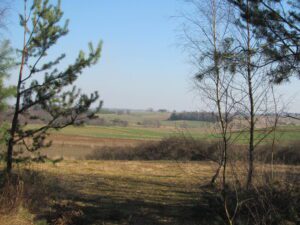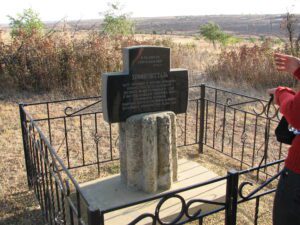Hoffnungstal, Bessarabia – History of a German Village (Part 6)
This is the final of 6 blog posts on my grandfather’s home village of Hoffnungstal, Bessarabia (now Ukraine).
Resettlement to Poland
The areas of West Prussia and Posen/Warthegau in northern and western Poland had been directly annexed to Germany. By the first part of 1941, the SS had expelled close to 400,000 Poles from their property in these areas, intending to settle ethnic Germans, including the Bessarabian refugees, there. With these lands available, most of the former Bessarabians were resettled and left the refugee camps fairly quickly. The uprooted Poles, many of them dying en route, were sent to the “General Government” or central and southern part of Poland, which was now occupied and administered by the Nazis.
Pawns in the Nazi settlement plans
The villagers of Hoffnungstal were originally intended to be resettled in the province of Danzig-West Prussia. However, the process was delayed and the people of Hoffnungstal ended up remaining in the refugee camps for about two years. Still in the refugee camp in 1942, the villagers of Hoffnungstal were the only of the Bessarabian mother colonies unable to celebrate the centennial of the founding of the village in their home.
The people of Hoffnungstal were told that the delay was due to the death of their mayor, Immanuel Aipperspach. However, coincidentally, during this same time the Nazis were revising their settlement policies. Anticipating Nazi victory, they were planning for the “Re-organization of Europe,” which included settling the General Government area with ethnic Germans. In late 1942 and 1943, more Poles were expelled from the Zamosc-Lublin area, many of them being sent to concentration camps or conscripted for labor.
The Hoffnungstalers were then given the choice of remaining in refugee camps for the rest of the war or being settled farther east than the other Bessarabians, in the General Government area nearer the war front. Desperately wanting to leave the refugee camp, not fully aware they had become pawns of the Nazi settlement policies, the people of Hoffnungstal, along with another Bessarabian village, agreed to be settled in the district of Lublin/Zamosc in December 1942—a small group of 4,000 ethnic Germans in the heart of Poland, surrounded by Poles with good reason to hate and fear anything German.
What mixed emotions the former Bessarabian Germans must have had as they settled into their new homes and became more fully aware of their situation. Relief that they were out of the refugee camps and able to work again as farmers and craftsmen. Justified in taking over these Polish farms, as they had left behind their own long-established and prosperous farms with the promise that they would be compensated for what they’d left behind.
And yet what dismay they must have felt knowing that the Poles had been forced from their homes and were now working for the German farmers as day laborers in what once were their own fields.

Source: Bundesarchiv Bild 183-1990-0323-501, Flüchtlingsfamilie in Oberschlesien./Licensed under CC BY-SA 3.0 de via Wikimedia Commons
“Front-line” farmers
The Poles, terrified by the expulsions by the Nazis and probably fearing that they would soon suffer the same fate as the Jews, formed partisan resistance units and struck out at anything German—making no distinction between the SS and the Bessarabian Germans whose only motivation was to be able to farm and work their own land again.
For more than a year of living in this area, the German villagers were constantly terrorized by Polish partisans setting their homes on fire by night and other violent acts. All men ages 18 to 65 kept a nightly watch and rarely got a full night’s sleep.
The attacks got so bad that the Germans asked the district SS commander to send the women and children to safety in Germany and the men would enlist in the army where they could “at least see the enemy in front of them.” They never knew which direction a partisan attack would come from. The SS commander told them to stop their complaining, sling a gun onto their backs and get behind their plows. After all, they were “front-line farmers.” An especially tragic set of attacks in June 1943 resulted in a large number of deaths in just one or two nights.
In 1944, the Russian army was advancing and the partisan attacks became even more brutal. Finally in March 1944, the women, children, and elderly were sent west for safety in refugee camps near Lodz. The men were required to remain in their Zamosc homes to fight and start that year’s crop. Finally in July, the battle front was advancing too quickly and the men headed toward Lodz with whatever possessions they could put in wagons. Many of the men of Hoffnungstal either died or were imprisoned by the Russians during the flight to Lodz. Those that made it to Lodz were either drafted into the German army or into labor battalions to build entrenchments.
Die Flucht (The Flight)
The last chaotic flight to escape the advancing Russian army occurred in January and February 1945. Leaving most of their possessions behind, they fled with whatever was available—wagon, some trucks, or on foot—toward Germany. Fifteen of the people from Hoffnungstal died as they fled ahead of the advancing war front. Another 23 people either disappeared while fleeing or may have been overrun and captured by the Russian army. (The specific fates of all of these people are not known, but some are known to have been deported to Siberia.)
A scattered community
Although the majority of the 2,088 Hoffnungstalers who were resettled in 1940 survived the war, after WWII they were scattered throughout Germany and were no longer a unified community. With the post-war division of Germany into East and West, many families were also separated by these political barriers.
Visits to Bessarabia, as part of the Soviet Union, were officially impossible until 1993 when Ukraine took over this territory (although some clandestine visits may have occurred). In particular, the site of Hoffnungstal was used as a restricted military area by the Russians and was therefore off-limits. Sometime after the Germans left, the Russians flattened the village (possibly using the deserted village for target practice during their training exercises) and the cemetery gravestones, and set up a military base and power station nearby. (It’s also possible that the village buildings were already damaged from an earthquake that occurred soon after the villagers first left in 1940.) The only structure that remained standing as of 2001 is the schoolhouse, which was taken away from its original location to be used as part of the power station.
In 1994, former residents of Hoffnungstal now living in Germany erected a memorial stone at the site of the former Hoffnungstal cemetery. In 1996, they returned to add a copper plaque with an inscription to the top of the memorial stone and held a service dedicated to the memory of their former home. The copper plaque later disappeared, and a more substantial stone memorial was built, commemorating the German settlers of Hoffnungstal, now a ghost town called Nadezhdivka, Ukraine.


Thank you for the entire 6 part blog of Hoffnungstal’s history. It is very well done and enjoyed by those of us who are researching our ancestors And it is also a ready reference for future writings. Thank you very much. Ada Deans
Thank you, Ada!
Thank you for the entire blog on an area in my general ancestral town of Alt Elft. Though other family members lived in other villages. I appreciate the research that you have done. Marilyn Thysell
The very same thing happened to the people from Basiryamka. My parents were relocated to Warthegau also, where I was born in Wreschen,Poland. Thank you for your blog.
@Marillyn – the people of Alt Elft would have gone through much of what the people of Hoffnungstal did. Details differ, but the history is the same.
@Heidi – I visited Basyramka in 2001 and had some lovely wine there! I’m so glad you enjoyed the blog.
Aloha from the Schmidt (off-grid) homestead up upon Mauna Loa on Hawai’i Island. Thank you for your thoughtful description of Hoffnungstal. My great-grandfather John L. Schmidt emigrated from Hoffnungstal to the Dakotas with his two surviving brothers Ludwig and Peter in 1884. Suffice to say, their ‘hopeful’ efforts to better their lives through their labor and perseverance in the face of obvious hardship is inspirational. Particularly, seven siblings of these three brothers apparently died in September 1878 in Hoffnungstal. Thus far, I’ve been unable to associate a cause of death from this time. Have any notions? Again, thanks for such edifying view into the colony’s history which has undoubtedly reverberated among its descendants’ lives going forward.
My mother, Ottilie Wallentin geb. Nagel 1912 in Hoffnungstal, experienced all those things you described in your blog and gave birth to 4 children on the way from Hanowka to Lodz.
My family talks about escape from the russians via Gotenhafen and shipment to Germany by sea.
Can you confirm that some people from Bessarabia did indeed travel by ship to Germany?
Hi Hartmut,
What a terrible situation our families experienced, isn’t it?
As for travel, the Bessarabian Germans definitely traveled by ship in 1940 from Galatz to some point in Germany (I’d have to go check my references where they disembarked).
In 1945, when they were fleeing through Poland from the Russian army, I’m not sure. All the stories I’ve heard were of fleeing on foot or by wagon. I haven’t heard of any fleeing by ship, but that doesn’t mean it didn’t happen. This site describes a ship trying to evacuate German civilians http://ww2today.com/30-january-1945-worst-ever-maritime-loss-the-wilhelm-gustloff.
So clearly, some German civilians did flee by ship. Whether any Bessarabian Germans got to those ports is unclear.
It’s also unclear because the Hoffnungstalers were settled quite far east in Nazi-occupied Poland (the General Gouvernment area) rather than in the western areas. So they would have had to travel a long way to get from the (for example) Zamosc area to Gotenhafen/Gdynia. And If they were fleeing, it would have been a more direct path to go from Zamosc to the German border farther south (I would guess, Frankfurt an der Oder and southward) rather than go a farther distance north to Gotenhafen/Gdynia.
But – it could be that they had to go further north to avoid the Russian advance?
Sorry – this is full of speculations and not much that’s concrete.